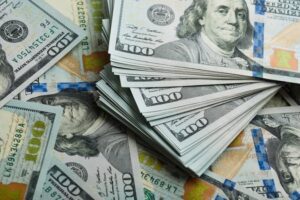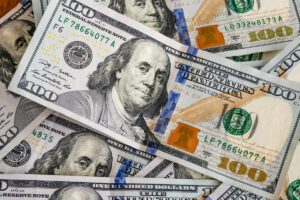
The U.S. dollar weakly appreciates against the euro and the pound sterling during the trading on Wednesday, continues to weaken in pair with the yen.
The day before the American currency plummeted in price following the release of the U.S. Labor Department data which showed a significant slowdown in inflation in the United States in November.
Last month consumer prices (CPI) rose by 7.1% year-on-year – the lowest since December 2021. The rate of inflation was down from 7.7% in October. Experts polled by Market Watch had on average expected a less significant slowdown to 7.3%.
The published statistics boosted investor hopes that the Federal Reserve (Fed) could halt the cycle of prime rate hikes sooner than previously expected.
The Fed concludes its two-day meeting on Wednesday. An overwhelming majority of experts expect the U.S. central bank to slow the pace of rate hikes in December after increasing it by 75 basis points (bps) at the end of the previous four meetings. The rate is expected to rise by 50 basis points to 4.25-4.5% at the December 13-14 meeting.
The euro/dollar pair traded at $1.0629 as of 8:00 a.m. Kk on Wednesday, compared to $1.0634 at the close of the previous session.
The pound exchange rate is $1.2257 by that time against $.2365 the day before.
The dollar fell to 135.44 yen against 135.59 yen at the previous trading session.
On Tuesday the American currency fell by 0.9% against the euro, by 0.8% against the pound and by 1.5% against the yen.
Meetings of the European Central Bank (ECB), the Bank of England as well as the Swiss and Norwegian central banks will also take place this week.
The European Central Bank, which meets on Thursday, may also slow the pace of key rate hikes to 50bp after increasing them by 75bp in October and September, experts expect.
The Bank of England, like the ECB, will hold a meeting on December 15. Analysts expect the British Central Bank, which raised its prime rate in November by 75 basis points. – maximum since 1989, will also decide to slow the rate increase to 50 bp.
EURO, pound, U.S. dollar, yen

ING analysts forecast US dollar and euro parity throughout most of 2023.
“The main conclusion we drew in our currency forecast for 2023 was that a repeat of the dollar’s dominant trend next year is unlikely,” according to the review.
As noted by analysts, everyone in the foreign exchange market is concerned about whether the dollar has peaked. Data on some weakening of inflation in the U.S. and hints at easing the “zero tolerance” policy on COVID-19 in China have combined to cause the U.S. national currency has fallen by about 8% from the highs of the end.
Those in favor of continuing the dollar’s decline are fully focused on the Fed’s actions and its reversal before a full-blown cycle of monetary policy easing.
“We certainly agree that a dovish reversal at the Fed – which will eventually lead to the start of a decline in short-term government bond yields – is a necessary condition for the dollar to fall,” the survey says.
However, it also requires that investments in Europe and Asia become attractive enough to take money out of dollar deposits, experts believe.
“It remains questionable whether any of these conditions will be met in 2023, and we remain skeptical that the euro/dollar pair can maintain gains above the 1.05 level,” the report said.

The U.S. dollar is declining against major currencies in trading on Thursday morning after a speech the day before by Federal Reserve Chairman Jerome Powell.
The ICE-calculated index, which shows the U.S. dollar’s performance against six currencies (euro, Swiss franc, yen, Canadian dollar, pound sterling and Swedish krona), is down 0.4%, while the broader WSJ Dollar Index is losing 0.6%.
During a speech at the Brookings Institution on Wednesday, Powell reiterated that the Fed could slow the rise in the prime rate as early as December. “The time to moderate the pace of rate hikes may come as early as the next meeting,” Powell said.
The Fed chairman, meanwhile, tried to balance those words with “hawkish” signals, Market Watch notes. He said that the U.S. Central Bank will have to raise the rate higher than could be expected a few months ago. In addition, Powell made it clear that the issue of rate cuts is irrelevant at the moment.
Another Fed official, Board of Governors member Lisa Cook is confident that the regulator needs to keep raising the rate because inflation is still too high. “We’ve started to get more favorable inflation data. But I would be cautious about drawing big conclusions on just one month’s worth of data,” Cook said during a speech at the Detroit Economic Club.
The euro/dollar pair as of 8:00 a.m. Ksk traded at $1.0445 versus $1.0410 at the close of Wednesday’s session.
The dollar/yen was down to 136.43 yen from 138.05 yen at the end of the previous session.
The pound is trading at $1.2103 versus $1.2058 the day before.

The U.S. dollar is moderately declining against major world currencies in early trading on Wednesday as market participants are waiting for Federal Reserve Chairman Jerome Powell to speak.
The index, calculated by ICE and showing the U.S. dollar dynamics against six currencies (euro, Swiss franc, yen, Canadian dollar, pound sterling and the Swedish krona), is down 0.3%, while the broader WSJ Dollar Index is down 0.2%.
Powell will speak at 8:30 p.m. ksc Wednesday at the Hutchins Center on Fiscal and Monetary Policy with an outlook on the economy and labor market. The event also includes answers to questions from the audience. Traders will closely follow the Fed chief’s statements, hoping to get signals about the future trajectory of monetary policy.
Last meeting, the Fed raised the rate by 75 basis points (bps) for the fourth consecutive meeting, and the rate is now at its highest level since January 2008 at 3.75-4% per annum. The last meeting this year will be December 13-14, and the market is expecting a rate hike of a more moderate 50 bps.
Earlier Federal Reserve Bank of St. Louis Governor James Ballard noted that the U.S. central bank will have to keep its key interest rate above 5% throughout 2023 and part of 2024. He also said there is no big difference between raising the rate by 50bp or 75bp at a separate meeting, and he leaves such “tactical” details to the head of the Fed.
The euro/dollar pair is trading at $1.0356 by 7:47 kk against $1.0331 at the close of Tuesday’s session, with the euro gaining about 0.25%.
The dollar/yen exchange rate is down 0.15% at 138.51 yen from 138.71 yen at the end of last session.
The pound is up 0.3% and trades at $1.1987 versus $1.1951 the day before.

The U.S. dollar is strengthening against the euro and the pound sterling in trading on Monday, becoming cheaper in pair with the yen.
The yuan exchange rate is declining amid the ongoing protests in China against covid restrictions.
The situation in China led to a decrease in appetite for risk in world markets that supports the dollar and yen, which are considered as “safe haven” currencies.
According to Bloomberg, protests were held in cities across the country, including the capital Beijing, as well as Shanghai, Xinjiang and Wuhan, which was originally the epicenter of the spread of COVID-19.
The ICE-calculated index showing the dynamics of the dollar against six currencies (euro, Swiss franc, yen, Canadian dollar, pound sterling and Swedish krona) added 0.39% on Monday, while the broader WSJ Dollar Index gained 0.25%.
The euro/dollar pair is trading at $1.0354 as of 7:55 a.m. Ksk, up from $1.0400 at the close of the previous session. The pound fell to $1.2050, compared to $1.2094 at Friday’s close.
The dollar fell to 138.44 yen against 139.19 yen at the close of the previous session. The euro slid down to 143.28 yen from 144.75 yen.
The U.S. currency pair with the yuan rose to 7.2053 yuan against 7.1654 yuan on Friday. The value of the dollar against the offshore yuan (traded in Hong Kong) rose to 7.2249 yuan from 7.1920 yuan.

Traders are waiting for inflation data in the U.S. for October, which will be released by the U.S. Labor Department on Thursday at 15:30.
Experts polled by Trading Economics forecast on average a slowdown in consumer price growth in the country to 8% year on year from 8.2% in September.
The U.S. inflation report for October is likely to be a key factor in determining how much the Federal Reserve (Fed) will raise rates at its December meeting.
The market is currently pricing in a 50 basis point (bps) rate hike in December, but a higher-than-expected October inflation rate could shift those expectations in favor of another 75 bps increase, Trading Economics notes.
The ICE-calculated index showing the dynamics of the dollar against six currencies (euro, Swiss franc, yen, Canadian dollar, pound sterling and Swedish krona) is adding 0.28%, while the broader WSJ Dollar is adding 0.33%.
The euro/dollar pair is trading at $0.9950 as of 3:30 p.m. MSC, compared to $1.0014 at market close on Wednesday.
The European Central Bank (ECB) on Thursday took steps to address a shortage of highly liquid government bonds on the market, which are used as collateral in market transactions. The problem has become urgent as the ECB has been buying bonds for years in a row as part of its quantitative easing program.
On Thursday, the ECB decided to increase to 250 billion euros from 150 billion euros the limit for securities lending to financial institutions against cash collateral, said Isabel Schnabel, a member of the ECB’s executive board.
“This is a precautionary measure to alleviate the shortage of securities collateral in the market and keep it functioning at the end of the year,” she wrote on Twitter.
The U.S. currency is at 146.47 yen versus 146.41 yen in the previous session. The pound rose to $1.1392 from $1.1357 the day before.
The dollar/yuan pair is trading at 7.2535 yuan against 7.2419 yuan at the close of the previous session.